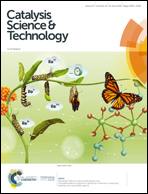Strain-induced changes to the methanation reaction on thin-film nickel catalysts
Abstract
We investigate how mechanical strain can directly manipulate the catalytic rate of a purely thermochemical reaction. Specifically, this work applies strain to a nickel-based thin film catalyst used in carbon monoxide methanation, which can serve as a key step in obtaining useful hydrocarbon fuels from biomass lignin. Previous computational literature has suggested that the application of mechanical strain can increase the activity of nickel-based catalysts in this reaction, making them a more attractive low-cost alternative to other more active catalysts. To directly apply strain in a high-temperature reactor, we designed a novel two-cell reactor which allowed us to use static air pressure to create a strained thin-film catalyst, ultimately measuring strain-induced changes in catalyst activity. In contrast with earlier theoretical predictions, increased tensile strain caused a decrease in activity rather than the increase which was originally expected. A re-examination of the computational reaction data suggests that the reaction model previously employed, which used a single parameter (CO dissociation energy) to predict catalyst activity, was overly simplified. It is likely that hydrogenation reaction steps have some rate-determining behavior and should be incorporated into the reaction model.



 Please wait while we load your content...
Please wait while we load your content...